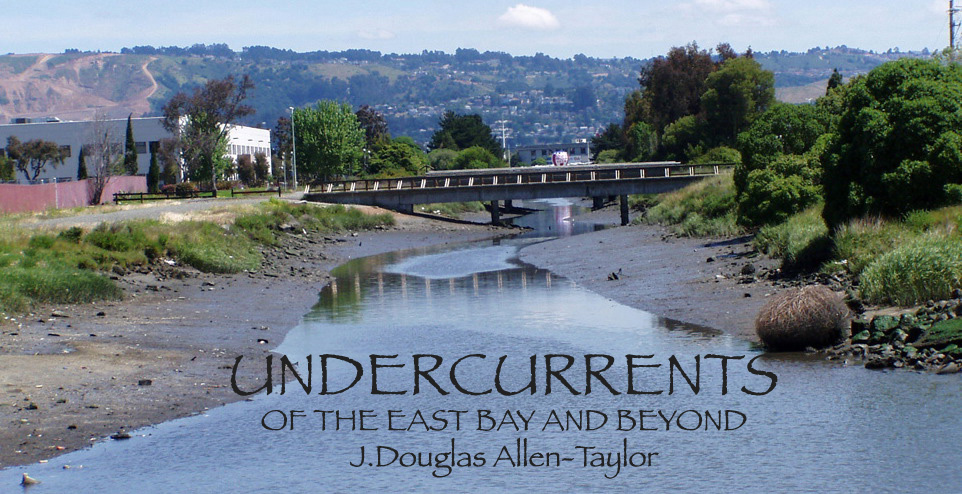|
|
PARKING IN OAKLAND
August 6 , 2009
The Grand Avenue-Lakeshore Boulevard commercial district has long been one of my favorite hangouts. For years, I would park at the old Lucky’s/Albertson parking lot and then walk up Lakeshore and then down around to Grand, window shopping, maybe making a purchase or two at the Gap—when its styles were more to my taste—renting a movie from Blockbuster, sitting down for coffee or sometimes a meal from one of the many Asian cuisine restaurants, almost always ending up for a half-hour or more of browsing at Walden Pond Books. I’m a sucker for a good used book store.
I had long before given up parking at the metered spaces on the two streets because I never had a clear idea about how long I wanted to wander the district and, besides, the street spaces along Grand and Lakeshore were almost always filled until blocks and blocks up either street, far away from the businesses.
When Lucky’s/Albertsons turned into Trader Joe’s and the proprietors put severe restrictions on parking, that pretty much killed my Saturday tours of Grand Avenue-Lakeshore, which could sometimes stretch into three hours or more. On Sundays I’d park along the south side of Lake Merritt until I noticed, one day, a parking ticket on a car in front of me and discovered, upon inspection of the street signs, that the Oakland City Council had unaccountably banned Sunday parking along that stretch. Why, I’ve never been able to figure out, but it effectively ended my weekend shopping in the district.
Instead, I turned to dropping by after six, when metering enforcement had ended and the street spaces began to clear up as well, and I could generally find one on Grand under the 580 overpass across from the Splash Pad.
One evening in early July, I parked over in that spot about 6:15 or so and walked around to Lakeshore to get a takeout dinner from the new Louisiana barbecue place that had opened up across the street from Trader Joe’s. Unfortunately, there was a sign on the window saying they had closed for an undisclosed reason, and were looking for another location. While I was there, however, I watched a woman come out of the 5th Amendment club just up the street—apparently having been informed that a parking enforcement officer was in the area—found a ticket on her car and said, disgustedly, to a group of men standing outside the club, “Yeah, I got one, too.”
I assumed that she had put money in the meter and it had run out before 6, or else she had parked just before 6 and not put any money in the meter at all, hoping the officer wouldn’t come in the area.
I found out different, of course, when I walked around to Grand and got a hot dog from the Day of the Dead café next to the Grand Lake Theater. The Day of the Dead has become one of my favorite new hangouts on the lake area avenues in part because you’re never quite sure what you’re going to encounter there, whether a long conversation with one of Oakland’s interesting characters, a poetry reading session, or a collection of musicians tuning up for a free jam session. It’s a throwback to the old 60’s counterculture establishments, and one that lends itself to leisurely indulgence.
Anyway, while I was eating and leisurely indulging outside at one of the café’s street talbes, I had a talk with Smoky Memel, the café’s co-owner and proprietor, who was fairly upset over the fact that the Oakland City Council had recently extended the parking meter hours from 6 in the evening to 8. He told me that he’d been hearing complaints already from drivers who’d gotten the unexpected after-6 tickets up Grand Avenue. “Don’t they know it’s going to kill the businesses on the street here?” Mr. Memel asked me, in an agitated refrain we’ve heard repeated over and over in the past month. And though Mr. Memel is generally a polite and good-tempered man, it was clear he was pretty angry.
I’d known about the Council’s struggle to balance the ’09-’10 budget, of course, but until then hadn’t heard details of the parking meter extensions. I tried to deflect Mr. Memel’s anger about the City Council by pointing out that in the years since the passage of Prop 13, radical fiscal conservatives had been using the referendum process to slowly cut off the various avenues by which California cities could raise funds, thereby leaving only the most onerous and unpopular. The goal of the conservatives, I explained, was exactly what was occurring, both to starve out local governments and make them unable to govern, as well as to stoke citizen anger about the methods used by local governments to raise funds. The ultimate purpose, I said, was to make the majority of California citizens anti-government. Mr. Memel remained unconvinced.
It was in the middle of this explanation that I realized that if the meter hours had been extended in the business districts on Grand and Lakeshore, they had probably been extended where I had parked as well, under the overpass, so I broke off the conversation and hurried back to move my car, so I wouldn’t get a ticket, thereby aborting the walk up to Walden Pond that I normally would have taken.
As much as I love Grand Avenue-Lakeshore I haven’t been back to the district since, and won’t go until I can figure out another parking strategy. Whatever the case, unless the city’s parking procedures in that area are reversed, I think my days of leisurely walking, window-shopping, eating, and occasional purchasing are over. If I go at all, it will be on a strict time schedule, and only for a specific purchase purpose.
I am only one minor shopper, and the sum total of my purchases in a year couldn’t sustain one Grand Avenue-Lakeshore business to keep its doors open for an hour. But I don’t think I am by myself.
While the Oakland City Council must take the responsibility for authorizing the new parking fee policies, it’s the office of the Oakland City Administrator—Dan Lindheim—which must take the blame for how it was implemented. The administrator’s office could have phased in enforcement, giving out warning tickets in the first week or two in order to warn drivers what was coming up. Instead, they chose immediate enforcement, a sort of “gotcha’” policy which pissed people off as much as, and maybe more than, the actual parking changes themselves.
Anyway, myself being personally assured that the members of Oakland City Council and the office of the City Administrator aren’t involved in some plot to destroy the Grand Avenue-Lakeshore business district and the other neighborhood commercial centers adversely affected, how in the world could something like this come about?
The answer lies in the Jerry Brown years, and the former mayor’s downtown-uptown-centric development obsession.
When Mr. Brown came into office in 1999, Oakland had a distinctly checkered retail map. Downtown had been dead for so long that only people in their 50’s could remember when it was once a thriving commercial center. The city’s retail life had shifted to several highly-successful neighborhood commercial districts: Grand Avenue-Lakeshore, Chinatown, College Avenue, the Fruitvale, Montclair Village, the Laurel. In addition, there were some neighborhood commercial centers in the more moderate-to-low-income sections of the city that were barely holding on—Eastmont Mall and Foothill Square, for example. And there were large stretches of the city—along International Boulevard from High Street to the San Leandro border, and almost all of West Oakland—that had some thriving local retail businesses, but nothing that could be characterized as a commercial center at all.
Mr. Brown had a distinct commercial policy choice to be made at the beginning of his administration. He could have put his attention on the rebuilding of the downtown-uptown center from the ashes, as he had promised in his 1998 election campaign platform (the so-called 10K promise, to bring 10,000 new residents downtown, thereby kickstarting a rebirth of the center city’s retail). Or Mr. Brown could have concentrated on shoring up the successful neighborhood commercial districts, making sure they remained successful, propped up the ailing ones, and built new neighborhood commercial centers where none existed in 1999.
Mr. Brown, as everyone knows, chose the former path, funneling the vast bulk of city development money into the Forest City Uptown and Fox Oakland restoration projects while letting the neighborhood commercial districts fend on their own. His promise was that the downtown-uptown development would bring extra money into the city through real estate transfer taxes as well as taxes from the newly-created businesses attracted by Forest City’s new uptown condominium complexes. Mr. Brown’s actions certainly transformed the uptown area. The gleaming new residential complexes are a much better sight than the crumbling and decrepit buildings they replaced, and “beautiful people” life has returned to the area, with upscale crowds patronizing several new restaurants along the uptown Broadway corridor.
But there is a distinct shallowness to Oakland uptown’s development, what the country folks used to call “a mile wide and an inch deep.” When the national and local economy took a nosedive towards the end of the Brown Administration, the promised boost to Oakland’s tax collections went with it. Condominiums went unsold, leaving a hole in the expected real estate transfer taxes. And while uptown upscale restaurants are thriving, the expected big ticket retail stores have not (yet) followed.
In the meantime, the opportunity passed for Oakland to shore up its neighborhood commercial centers. Shopping centers like Foothill Square and Eastmont Mall have gone downhill in the past years—Foothill Square lost its anchor supermarket tenant, and Eastmont has survived only by replacing its retail components with government and health services activities. With few exceptions, the large stretches of Oakland communities that were underserved by retail in 1998 remain just as underserved 11 years later. Meanwhile, the major impediment to the expansion of the successful neighborhood centers—a shortage of available parking—was never addressed by city government. And in fact, rather than solving the problem in a way that brings more patrons into the successful neighborhood commercial districts, it is that parking shortage that the city now attempts to take advantage of in these times of city budget shortages.
When Ron Dellums was elected mayor of Oakland in 2006 to succeed Jerry Brown, he did little to change those Brown commercial development priorities. While Mr. Dellums has certainly done many things different, the Brown retail development engine was roaring down a particular road with such momentum, a complete slamming on the brakes and rapid turning of the wheel by the Dellums Administration was needed to reverse that course. Gradualism would not do it.
Public policy works on the principle of inertia. Most people confuse the term “inertia” as meaning moribund, something standing still, bogged down, unable to move. The actual meaning of the term is scientific: “the tendency of matter to remain at rest if at rest, or, if moving, to keep moving in the same direction unless affected by some outside force.” Both parts apply to our present situation in Oakland’s commercial policy. The momentum from the Brown Administration putting attention on downtown-uptown development continues, even if the Brown development theories (that retail would automatically follow residences) never made sense in the first place, and have proven to be a miscalculation. Meanwhile, the neglect of the city’s neighborhood commercial district continues as well, leading city officials to continue to try to pull more and more money out of these areas—in the form of extra parking fees and fines, for example—in order to keep the city financially afloat, rather than see these districts as precious commodities which need to be protected and cultivated, less they eventually crash or wither away…
…as the old downtown did.
|

